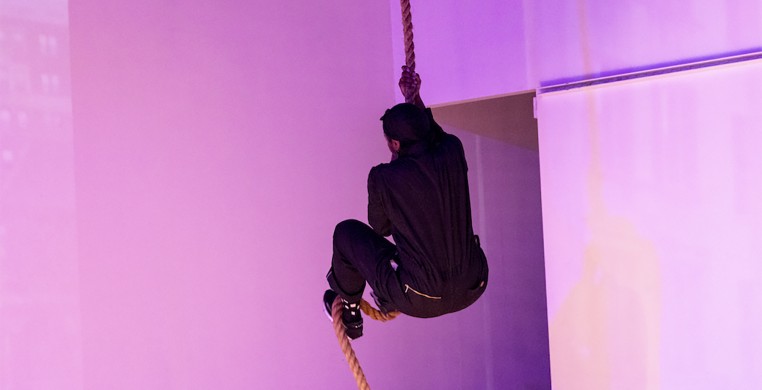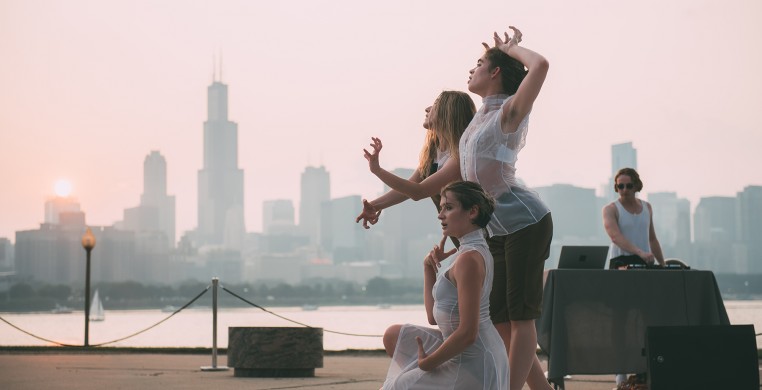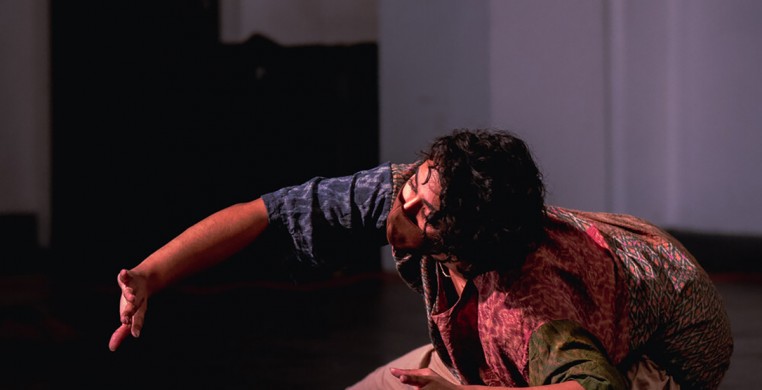Fans of dance in Chicago know where to look to find their favorite artists and companies. Up and coming artists regularly grace the blonde-wood floor of Links Hall. Larger companies fill the main stages at the Athenaeum up north and the Studebaker downtown. Local legacy and out of town touring companies put on must-see shows at the Auditorium or the Harris.
Of all the theaters who host dance, the name Steppenwolf rarely comes to mind. But that may be about to change thanks to the LookOut series.
Steppenwolf began the LookOut series in 2016 to present work by companies and artists across a wide range of genres and forms and at different stages in their careers. Since then, the theater has hosted performances by Lucky Plush Productions, Ginger Krebs, The Seldoms, Kelly Anderson Dance Theatre and the “punk Mozarts of dance,” Boomerang. This year, there are already plans in the works to feature more dance as part of the new Work Around series.
Work Around is a six-show series over two-weeks featuring three Chicago dancemakers—Tuli Bera, Cat Mahari and Drew Lewis—and is the brainchild of dancers turned producers Kara Brody and Amanda Maraist. In an interview, Brody credits her time working with Lucky Plush, both as a performer and as an administrator, for helping to establish a connection with Steppenwolf. In fact, they approached her!
“I’ve performed there with Lucky Plush Productions,” said Brody, “and, following the success of those and similar performances, [Steppenwolf] proposed this amazing and supportive series that features more of the Chicago dance community and also is open to new structures that can help support them.”
Of course, this is a big job for one person to handle alone, so Brody called in support. “I invited my friend and dear colleague, Amanda Maraist, to help run the series. It’s exciting for us, and for the community, to have a space that provides resources to artists for their work, wherever they are at in their process.”

Work Around Curators (left to right) Kara Brody and Amanda Maraist, curators of LookOut’s work around series. Photo by Chien An Yuan.
Maraist, a veteran Chicago dancer, expressed a matched enthusiasm about Steppenwolf’s proactive approach. “Essentially, Steppenwolf is giving us license to have two weeks in the theater and fashion it however we like,” said Maraist. “They basically gave Kara and me free agency.”
The series kicks off on Feb. 4 & 5 with “Blk Arc: The Impossible Manifestation” by Cat Mahari, a work-in-progress that embodies the spirit of Hip Hop culture and the “destiny of marronage,” the process of extricating oneself from slavery. Fueled by Hip Hop, Black street dance styles and backed by extensive research on social movements, in describing the show Mahari asks the questions, “What will it take to get free?'' and “Can we see a new world from here?”

Blk Arc (pictured) Cat Mahari, whose work Blk Ark: the impossible manifestation (work in progress), is featured as part of the work around series. Photo by Elisabeth Seonwoo
On Feb. 9 & 10, Tuli Bera combines her love of the culinary arts with her passion for dance in “Bangali Meye,” a work that has been developing since 2019. “This third iteration speaks to ‘food memory,’” said Bera, “and will be part cooking show, dance and movement (I almost want to say drama since I pull more from a theatrical place). I like to think it’s universal, that food brings out these memories in us; chopping an onion, grinding spices, the sound of sizzling oil… that can take you somewhere.”
Bera, a first-generation American whose parents are from West Bengal, is a classically-trained ballet dancer in the Vaganova tradition, but also incorporates a wealth of other dance influences, like South Asian forms—Bharatanatyam, Kuchipudi, Rajasthani folk dance, and more—and Western forms— modern/contemporary, jazz, contact improv, ariel dance. Despite Bera’s non-traditional training, there is no denying her ballet roots. “I have spent many years rejecting [ballet], but even if you reject something it’s still in you; the perspective is different, but it’s still there.”
This version of “Bangali Meye” features the addition of Bera’s sister, Anita Bera. “That’s a very new thing for me to do, to invite a family member into my creative process, and she’s a very big influence on what we’re going to be presenting. We both love to cook and that’s something we’ve been doing a lot lately, so [the work] is born out of what our daily lives are like.”
Closing out the series, Drew Lewis draws inspiration from a kindred spirit in his work “Heavy Objects,” performed on Feb. 11 & 12. “Heavy Objects” is performed by a trio of dancers—Maddy Joss, Isabella Limosnero and Lewis—and pays reverence to artist and activist, David Wojnarowicz, whose work gained prevalence during the 1980s and early 1990s during the AIDS crisis.
“He’s a writer, painter, filmmaker, photographer—an all-around artist and activist who I have followed throughout my young adult life,” said Lewis in an interview, “He’s passed in 1992, but his work has heavily influenced me throughout my development as a choreographer, but I’ve always wanted to create a piece that was intentionally paying homage to him.”

Heavy Objects (pictured) A publicity image for Heavy Objects by Drew Lewis, part of the work around series. Photo by Michelle Reid.
Maraist sums up the event nicely, saying that “We thought this would be a great opportunity to present all of the different stages of work on an even playing field. Each of the three artists that we’ve chosen are at really different places in their process, which I think is so exciting. One is more like a technical residency with a performance at the end. Another is using this as, like, an informal first iteration of a new work, and another is just straight up doing a show with full tech. Presenting all of those in the same series, I think, is really exciting!”
By now it’s old news that the dance world is opening back up post-COVID. What is news is that a theater with such pedigree and recognition as Steppenwolf is interested in presenting more dance. Will the extra exposure drive an interest, and a demand, from Steppenwolf’s audience? Could this cause a ripple effect, getting more prominent theaters to expand their dance programming? Time will tell.
One thing is certain: that the team of Kara Brody, Amanda Maraist and the folks at Steppenwolf are committed to give opportunities to a wide range of dance artists, and that the Work Around series may not only change how we see dance, but where we see dance.
--------------------
The Work Around series runs Feb. 4 – 12 at Steppenwolf’s 1700 Theater, 1700 N. Halsted St. Tickets are $5 - $30. To purchase tickets and check show listings, visit Steppenwolf.org or click the event tabs below.

